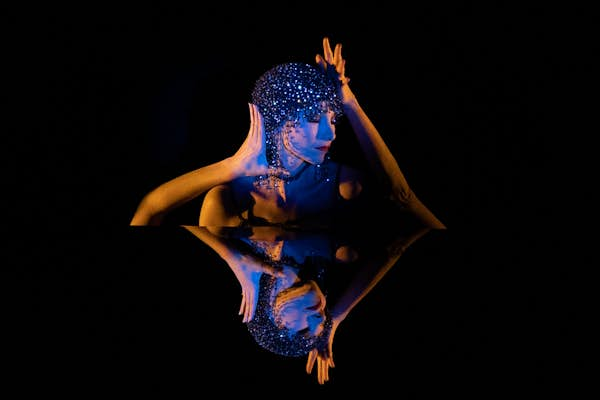
France-based travel journalist Anna Richards understands the allure of the Moulin Rouge and why that may be your first preference for cabaret while in Paris – but here’s why she thinks you should consider the Crazy Horse.
Cabaret dancer Lola Kashmir doesn’t divulge her “real” name to me.
When dancers perform their debut show at the Crazy Horse in Paris, they’re given a “Crazy Girls” name. Chosen for them based on their preferences, origins and dance style, this identity becomes so entrenched that even during a night out with her fellow dancers, Kashmir’s stage name never slips.
Such illusion and mystique are what the Crazy Horse is all about.
You’ve surely heard of the Moulin Rouge, where dancers high-kick in petticoats and tights. At the Crazy Horse, by contrast, performers take the stage dressed in no more than light and shadows.
Get the inside scoop on the latest cultural happenings all over the world delivered weekly to your inbox with our email newsletter.  Moulin Rouge performers © Getty Images for ABA
Moulin Rouge performers © Getty Images for ABA
The Moulin Rouge might offer the expected French cabaret experience in Paris…
The famous Moulin Rouge first opened its doors in 1889. Its prevalence in popular culture – the joint loaned its name to not only Baz Luhrmann’s 2001 blockbuster but also John Huston’s 1952 musical – have made the theater and its illuminated red windmill famous the world over.
In France and across the globe, most cabaret clubs mimic the traditional format popularized at the Moulin Rouge: scantily clad women (and some men) perform a sequence of dances as the audience enjoys dinner. The showstopper is the French cancan, an energetic fiesta of leg kicking, shimmying petticoats and high-pitched whoops.
Like the Moulin Rouge itself, the dance was born in Montmartre, invented by 19th-century washerwomen. Sick of being bossed around by their husbands, they expressed their discontent by transforming the menial chores they had to do into dance moves. Many of the signature routines of the cancan derive from movements associated with such housework: serving drinks to thirsty husbands, scrubbing laundry and even making condiments. To this day, cabaret dancers learn and perform le tire-bouchon (corkscrew), le lavoir (washhouse) and la mayonnaise.
But you won’t find such moves at the Crazy Horse, which first sashayed its way onto France’s cabaret scene 60 years after its better-known progenitor.
 The Crazy Horse features the ultimate in sexy sophistication © Marc Piasecki / Getty Images
The Crazy Horse features the ultimate in sexy sophistication © Marc Piasecki / Getty Images
…but here’s why you should try the Crazy Horse instead
“The style of dance at the Crazy Horse is different, and completely unique,” says Kashmir. “It’s a combination of cabaret and burlesque.”
When Alain Bernardin opened the Crazy Horse in 1951, he seemed to seek every chance to distinguish the club from its rival in the 18th arrondissement. The Moulin Rouge was in higgledy-piggledy, artsy Montmartre, full of bohemians, radicals and bon vivants (and a fair share of sex shops, too). The Crazy Horse, on the other hand, has an address on Avenue George V, a stone’s throw from the Champs Élysées, opposite the YSL flagship store and next door to Balenciaga. More intimate, the Crazy Horse had (and has) just 220 seats compared to over 800 at the Moulin Rouge. And in 1968, when full nudity on stage became legal, Bernadin took his differentiation a step further.
From that point on, his dancers were to perform naked, dressed solely in the tiniest accessories – and oh-so-tasteful shadows and light.
Of the 20-odd dances in the Crazy Horse lineup, some have been in the repertoire since the ’50s, with others choreographed just this year. Even guests who see two Crazy Horse shows on the same day won’t see exactly the same performance. Each lineup features the troupe of 15 full-time and 20 part-time Crazy Girls, interspersed with performances by various hip-hop dancers, singers and contortionists.
The approach to learning new dances is intense and immersive. For one routine, “God Save Our Bareskin” – a dance inspired by the guards outside Buckingham Palace – one of Queen Elizabeth II’s guards deployed from London to Paris to teach the Crazy Girls to walk, stomp and salute like a real royal sentry.
Elton John, Edith Piaf and Ella Fitzgerald are but a few of the big names to have performed at the Moulin Rouge – but the Crazy Horse has had its share of star-studded guests, too, including Pamela Anderson, Conchita Wurst and Dita von Teese. (The last of the three choreographed one of the most famous acts in the 90-minute Crazy Horse show, “Undress to Kill.”)
 Crazy Horse dancers take the stage covered in not much more than shadow and light © Kristy Sparow / Getty Images
Crazy Horse dancers take the stage covered in not much more than shadow and light © Kristy Sparow / Getty Images
For Kashmir, the Crazy Horse’s non-traditional approach was her passport to the cabaret world. In her native New Zealand, cabaret and burlesque were virtually nonexistent. While she had trained as a contemporary dancer, she never felt that dance style encapsulated her personality – so she saved to fly to Paris and audition for the Crazy Horse.
The gamble paid off, and she began her training in 2019. Since the Crazy Horse’s choreography and dance techniques were completely different to those of other cabaret clubs, Kashmir wasn’t the only one starting on the back foot: none of her fellow dancers had ever done anything like this, either.
“Coming from New Zealand, I feel honored to perform on such a historic stage in the capital of cabaret,” says Kashmir. “But most of all, performing dressed just in light at the Crazy Horse feels powerful.”
How to make it happen
The Crazy Horse has two shows daily, and three on Saturdays. Reservations can be made online: tickets start at €135 (which includes a bottle of rosé).



